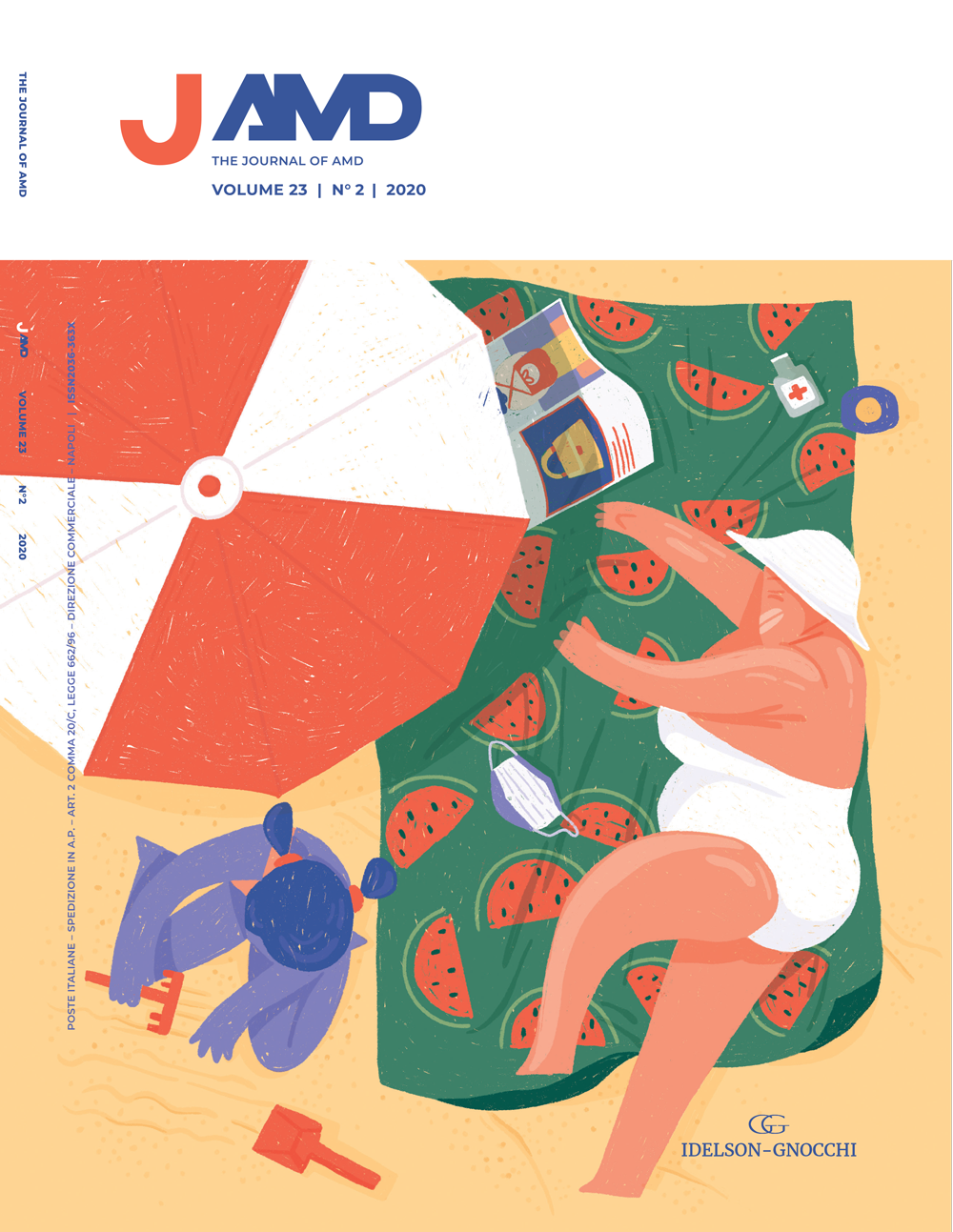Research article
Undesirable effects and persistence of gliflozine treatment in patients with type 2 diabetes mellitus
JAMD 2020;23(2):102-110
OBJECTIVE OF THE STUDY SIDECAR (SGLT2-Inhibitors in Diabetes: Evaluation of metabolic Control and Adverse events in the Real-world), is a monocentric prospective observational study performed to monitoring in clinical practice patients with type 2 diabetes (T2D) treated with SGLT2-i to evaluate metabolic and anthropometric evolution during time, as well as the onset of adverse effects (AEs).
Design and methods. Demographic features, T2D duration, and clinical parameters at baseline have been recorded as mean ± Standard Deviation (SD) for continuous variables, and frequency distribution for discrete variables. A repeated measures regression model was utilized for the evolution during time of parameters. AEs prevalence were recorded with stratification for main clinical and demographic features at baseline.
RESULTS N=220 patients, with 18 months available follow-up, treated with SGLT2-i (N= 19 canagliflozin, 8.6%; N=91 dapagliflozin, 41.4%; N=110 empagliflozin, 50%) monotherapy or in combination according to AIFA indications). Really effective was the action of SGLT2-i on glucose metabolism, with rapid reduction in HbA1c and fasting plasma glucose after 6 months, as well as after 12 and 18 months (HbA1c: -1,0%; fasting plasma glucose: -34,8mg/dL). Weight and BMI showed a satisfying improvement, while waist circumference was statistically significant only after 12 months. Blood pressure, total cholesterol, and renal function were not modified by the treatment. But, apart from the valuable effects on metabolic parameters, 86 patients (39%) suspended SGLT2-i treatment mainly because ineffectiveness (15,7%) or for Genito-Urinary Tract Infections (GUTIs) appearance (14,3%).
CONCLUSIONS Median term follow-up confirms the efficacy of SGLT2-i, but a significant percentage of patients is forced to suspend these drugs especially for GUTIs appearance. Such high prevalence of non-serious AEs limits the potential nephro-cardiovascular benefits related to SGLT2-i utilization. A possible chance to reduce GUTIs should come from single tablet association of SGLT2-i and DPP4-i actually available on the market.
KEYWORDS type 2 diabetes; SGLT2 inhibitors; genito-urinary tract infections; real world evaluation; health education.
What future for therapeutic education (TE)?
JAMD 2020;23(2):111-117
The exponential increase in cases of type 2 diabetes mellitus (T2DM), particularly in developing countries, is combined with the progressive failure of healthcare facilities to provide adequate assistance.
The role of Therapeutic Education (TE) in the treatment of T2DM has long been certified. However, despite efforts to implement educational interventions, these have proved to be largely insufficient in meeting current needs. Diabetology – like modern medicine – has therefore been looking into digitization as a possible solution.
The increasingly widespread diffusion of the Network and the means for accessing it have in fact triggered a full-fledged race to computerization, a growth that is not always consistent.
TE could not get away from these new circumstances. The digital world offers opportunities for reviewing and updating TE without denying or replacing its recent and prestigious past.
This new way of doing TE, however, requires attention and new skills to be acquired and tested extensively.
KEYWORDS therapeutic education; health literacy; digital therapeutic education; video; social media.
Punto di vista
What future for therapeutic education? A comment
JAMD 2020;23(2):118-119
Reviews
The physician, the illness, the Covid-19
JAMD 2020;23(2):120-125
Often doctors feel alien to the disease, they think that it is a problem of patients, that it does not touch them and will not touch them directly: however, when for some reason they get sick, the perspective changes totally. Getting Covid- 19 is a profoundly different experience, because it is a disease known for three months, for which natural history is not known and no drug treatment is safe and effective. There is no evidence- based security, only fear, empirical care and the deep loneliness of isolation. In such ad dramatic situation, randomized controlled trials would be vital, but you have to learn while acting, treating and producing data together. The western world was unprepared for this event, forgetting that epidemics have always been scourges for the humanity and that they require a community-centered approach. It is now necessary to break the cycle of “panic-then-forget” and to pursue the priority of funding and the implementation of effective preparation interventions. After the Covid- 19 outbreak, medicine will be more humble and concrete and will have a different view of prevention. We too will be more aware of being precarious and fragile.
KEYWORDS Covid-19, severe acute respiratory syndrome coronavirus 2.
Heart failure therapy in patients with diabetes
JAMD 2020;23(2):126-134
The great interest in the problem “Heart failure” (HF) by the diabetologist has been born in recent years and is mainly linked to the availability of new antidiabetic drugs which have shown a significant benefit in reducing hospitalizations for heart failure and cardiovascular mortality.
Diabetes patients have more than double the risk of developing HF compared to patients without diabetes. The Framingham study has shown that diabetes increases the risk of heart failure up to 2 times in men and 5 times in women compared to controls over age. In addition, 12% of patients with DMT2 have heart failure and 30% of patients with heart failure are diabetic.
Hospitalization for HF is associated with very high rates of both post-discharge mortality and new hospitalizations.
Readmission rates for clinically stable patients discharged after recent hospitalization for HF are approximately 25% at 6 months and all-cause mortality exceeds 30% at 1 year. In particular, a worse prognosis and a longer hospital stay are associated with hospitalized diabetes patients.
There is a close correlation between metabolic compensation and HF. In fact, in patients with diabetes a 1% increase in HbA1c is associated with an 8% increase in the risk of HF and still the improvement of the glycometabolic control reduces the risk of HF (in the UKPDS the 1% reduction in HbA1c was associated with a 16% reduction in the risk of HF occurring).
KEYWORDS T2DM; heart failure; SGLT2-inhibitors; diabetic cardiomyopathy.
Case reports
Treatment with rivaroxaban and ASA, after successful endovascular recanalization, in a subject with multi complicated peripheral arterial disease. Case report
JAMD 2020;23(2):135-138
Preserving the clinical result of revascularization in diabetic patients, usually affected by a complex and often progressive form of arteriopathy, is a mandatory challenge to reduce major amputations rate and the related mortality rate as well. Low doses of the new NOAC anticoagulant drugs, more manageable than traditional coumarin drugs, if associated with ASA and / or clopidogrel, have shown a significant efficacy in thrombosis prevention, in subjects who underwent endovascular or surgical revascularization. Contraindications end cautions are necessary in subjects with ESRD, dialysis, mechanical prosthetic heart valves and old in age.
KEYWORDS peripheral arterial disease; diabetes; thrombosis; anticoagulants.
Dalbavancin in the treatment of patients with Gram-positive diabetic foot infection: a case report
JAMD 2020;23(2):139-142
Dalbavancin is a potent lipoglycopeptide active against Gram+ bacteria with a favorable pharmacokinetic/pharmacodynamic (PK/PD) and safety profile, suitable for numerous challenging infections. Dalbavancin has been approved for ABSSSIs, but its range of application and the relative posology is still debated. Diabetic foot infections are a major challenge and a leading source of complications, involving high direct and indirect costs for healthcare systems and for patients in terms of morbidity and disability. Gram+ bacteria are often causative agents in diabetic foot infections. We discuss here the case of a 43 yars old patient with complicated diabetic foot infection and the successful application of a dalbavancin secondary monotherapy treatment protocol. The patient, after suffering a two months complex hospitalisation gained wound haeling and limb rescue without any complication. We were also able to measures dalbavancin plasma levels determining its long half-life and high microbial killing ability.
KEYWORDS dalbavancin, diabetic foot, gram-positive.
Position Statement
Recommendations for the diagnosis of Gestational Diabetes during the COVID-19 pandemic
JAMD 2020;23(2):143-146
Recommendations for the care of pregnant women with type 1 Diabetes, type 2 Diabetes and Gestational Diabetes during the COVID-19 pandemic
JAMD 2020;23(2):147-155
Attività dei gruppi
Emergenza coronavirus e stress
Coronavirus emergency and stress
JAMD 2020;23(2):156-157
“Parlo di me con te”. Il progetto AMD/SID“
I talk about me with you.” The AMD/SID project
JAMD 2020;23(2):158-160
Le news di AMD
Newsletter Annali AMD n. 27
AMD Annals Newsletter n. 27
JAMD 2020;23(2):161-162




